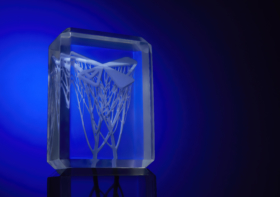Kinematics Link Bodice

A few years ago, we started thinking about applying the design+simulation techniques of our Kinematics system to other types of textile structures like chainmail. The Kinematics Dress is made up of hinged triangles which tessellate to cover the body. The hinges not only create a garment with fabric-like motion but also enable us to fold the garment computationally to produce a smaller configuration for efficient 3D-printing. Hinges have a very limited range of motion though, only allowing for rotation around a fixed axis. A loose, unconstrained structure like chainmail should be able to compress much more compactly.
Recently, Formlabs contacted us about using some of our designs for their new secret project, an affordable SLS 3D-printer, the Fuse 1. They were particularly interested in printing one of our garments, but their machine is MUCH smaller than the 3D printer that fabricated our other garments. Our dresses are printed on the largest EOS printer at Shapeways, which has a build volume of 65x55x35 cm. The Formlabs Fuse 1 is only 1/14th the size of that machine. A Kinematics Dress definitely wouldn’t fit in there! Rather than dismiss the idea of being able to print clothing in such a small build volume, we built a new chainmail system to achieve much greater compression.
We fit a Kinematics Link bodice (US size 6) in about half the build space of the Fuse 1. The bounding box of this prototype was 13x13x16.8cm, approximately 4% of the bounding box of the unfolded design. That’s a lot of compression! The Kinematics Link Bodice is composed of 11,311 interlocking parts, making it the most intricate garment we’ve ever created (the most intricate kinematics dress we’ve made only had 3,212). With this level of detail, the resulting garment is considerably lighter, more flexible, and more fabric-like than our previous garments.

This is still an early phase of the project. Once we’re a little further along, we will release more information about the design system and simulation we invented to make this garment possible.






Shab Bhat
This certainly does look like the real fabric, with 3D printing designing clothes and accessories gets more wider and provides more options for the buyers. Many 3D printing service companies have designed and are even making available to the customer, the 3D printed shoes and some other basic accessories. But, 3D printed fabric which looks and feels like real fabric, is surely a new thing.
Zachary Ferguson
Amazing work! I am curious, what simulation software or library did you use to simulate the chainmail?
Zachary Ferguson
Amazing work! I am curious, what simulation software or library did you use to simulate this chainmail? Also how long did the simulation take?
Jessica
We have our own software which is based on Position Based Dynamics. It takes about 5-10 minutes to do the simulation.